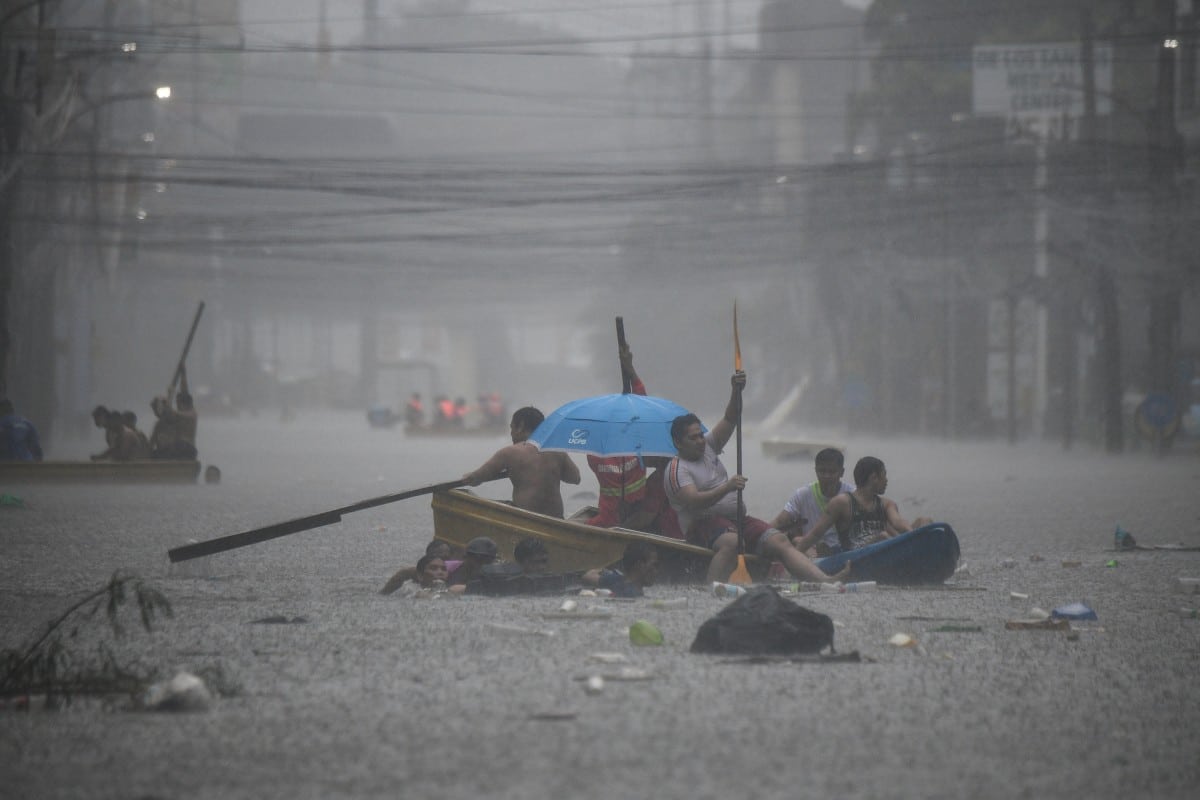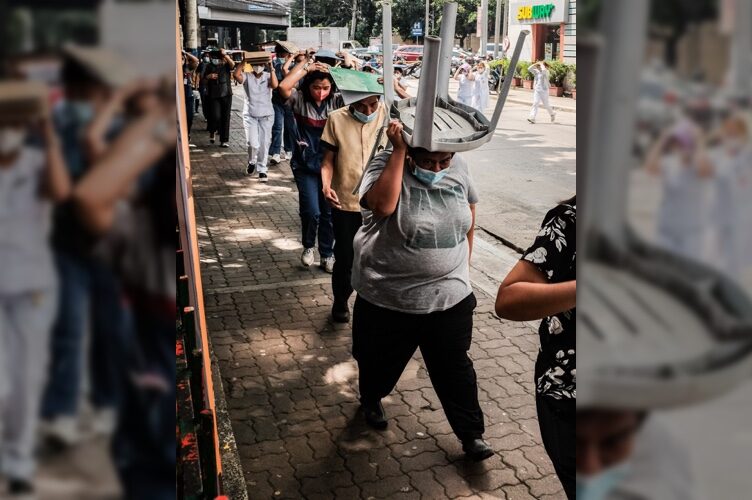THE Department of Public Works and Highways blamed overpopulation and the public’s “improper” garbage disposal as to the recent flooding in Metro Manila brought about by Super Typhoon Carina and the southwest monsoon.
In a radio interview (Teleradyo), DPWH Secretary Manual Bonoan said that they are ready to explain to lawmakers and individuals as to the NCR floods.
“We are ready to explain (to lawmakers) if asked about what the Department has done,” he said.
Likewise Bonoan said that with regards to the flood control, “we can implement engineering intervention but if people continue the improper disposal of garbage, then that would clog the waterways for flood waters.”
“If we no longer have trees in the mountains, there would be a lot of soil from erosion that would go to our rivers,” he added.
DPWH Usec. Cathy Cabral for her part said that Metro Manila has already exceeded its carrying capacity.
She said this contributed to the recent flooding.
Courtesy: AFP
Cabral says the DPWH is actively assisting in the relocation of informal settlers to address the issue.
She adds, the DPWH has already implemented over 600 flood control projects in Metro Manila, but the overpopulation is clogging the waterways.
NCR has 14.9 million population, as of 2023.
DPWH-Metro Manila Director Loreta Malaluan said that the recent heavy rains coincided with the high tide.
“Nataon po na nung kalakasan po ng ulan ay sabay din po naman na nag-high tide kaya nga po itong mga nasa tabi po ng ating mga coastal areas, tulad po nung ating Camanava (Caloocan,Malabon, Navotas and Valenzuela),” Malaluan said in a separate interview at the same radio station.
Likewise she said that trash that accumulated in waterways slowed the drainage process.
“Yung sobrang basura din po sa ating mga waterways ang isang dahilan kaya po medyo mabagal po na lumabas yung ating tubig-baha,” she said.
Courtesy: AFP
She also said that the DPWH’s flood control infrastructure, which includes pumping stations, could not handle the unprecedented volume of water.
“Tumaas po ang mga lebel ng tubig natin po sa ating mga waterways… Ang isa nga po diyan dito [ang] Pasig-Marikina River.. Ganoon din po dito sa La Mesa Dam,” the official said.
“Medyo ang mga flood control projects po natin, especially po yung ating pumping stations na hindi po sila napagana nang husto, dahil nga po mas mataas yung lebel ng tubig na paglalabasan ng mga napu-pump nila na mga tubig-baha kaysa po dun sa elevation natin dito sa pumping station,” she explained.
But the DPWH is committed to completing ongoing flood control projects.
Former Commissioner of the Presidential Anti-Graft Commission (PAGC), Atty. Nick Conti,called on both the Senate and House of Representatives as well as the Commission on Audit to conduct a comprehensive audit of all flood control projects.
“This call comes in response to the recent state of calamity declared in the National Capital Region (NCR) due to massive flooding. Despite substantial budget allocations for flood mitigation, the persistent flooding problems highlight severe inefficiencies and possible corruption,” Conti said in his appeal.
Courtesy: AFP
“People pay taxes in exchange for government programs and services, including safety and security during calamities such as typhoons and widespread flooding. However, the public’s trust is undermined when these services fail to deliver, especially given the significant funds allocated for flood control,” he added.
For 2024, the Department of Public Works and Highways (DPWH) has proposed a P245 billion budget specifically for flood control projects.
This follows a budget of P185 billion in 2023, reflecting the government’s continuous financial commitment to addressing flooding issues.
Conti emphasizes that the rampant flooding in areas such as Quezon City, Mandaluyong, and Manila highlights the mismanagement and possible corruption within these projects.
Additionally, Conti said, citizens face increased expenses for the rehabilitation of their flooded homes, damaged properties, appliances, and vehicles—a double whammy. The public not only suffers from the initial flood damage but also incurs additional expenses for rehabilitation and repairs.
“The call for an audit is not just a financial scrutiny but a moral imperative to protect citizens from the continual distress and danger posed by ineffective flood control measures. With the DPWH’s proposed budget of P245 billion for 2024, there is an urgent need to account for these funds and rectify any malpractices,” he said.
This amount, according to data from Conti, noted that the DPWH budget is higher than the entire budgets of several key departments under the Executive Branch:
Department of Labor and Employment (DOLE): (₱61.2 billion)
Department of Environment and Natural Resources (DENR): (₱25.3 billion)
Department of Justice (DOJ): (₱36.2 billion)
Department of Tourism (DOT): (₱3.4 billion)
Department of Trade and Industry (DTI): (₱8.6 billion)
Department of Energy (DOE): (₱1.6 billion)
Department of Science and Technology (DOST): (₱26.9 billion)
Department of Information and Communications Technology (DICT): (₱6.9 billion)
Department of Foreign Affairs (DFA): (₱24.6 billion)
Department of Finance (DOF): (₱23.9 billion)
Department of Budget and Management (DBM): (₱2.5 billion)
Department of Agrarian Reform (DAR): (₱8 billion)
He added that the flood control budget surpasses the entire annual budgets of these departments, highlighting the government’s prioritization of infrastructure resilience and disaster preparedness.
This significant allocation underscores the critical importance of flood control in mitigating the impacts of climate change and protecting the populace and economy from flood-related disasters.
Courtesy: AFP
By comparison, the ₱245 billion allocated for flood control is more than: Four times the budget of DOLE; Almost ten times the budget of DENR; Ten times the budget of DFA, and DENR; Nearly thirty times the budget of DTI; Over one hundred fifty times the budget of DOE.
“These comparisons make it clear that the flood control budget is a substantial portion of the national budget. In light of the current state of calamity, it is crucial that the government reassesses its approach to flood management, prioritizes anti-corruption measures, and ensures that the infrastructure projects genuinely serve the public interest. The ongoing suffering of the people must be addressed through decisive and transparent actions,” Conti remarked.
Presently, the Senate is set to investigate flood control systems.
Senate President Francis Escudero has questioned the effectiveness of flood control measures and the use of the substantial budget allocated for these projects.
He said around P255 billion was allocated for DPWH flood control projects, which Escudero previously criticized as disproportionately large compared to other critical sectors.
How useful was this post?
Click on a star to rate it!
Average rating 0 / 5. Vote count: 0
No votes so far! Be the first to rate this post.
We are sorry that this post was not useful for you!
Let us improve this post!
Tell us how we can improve this post?









